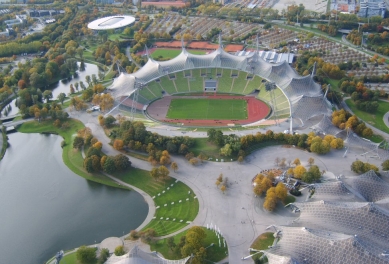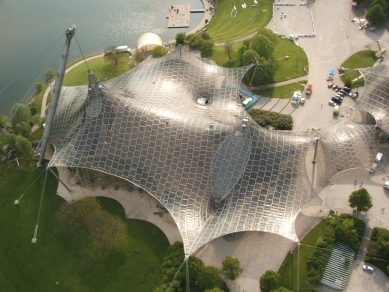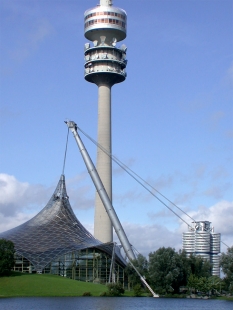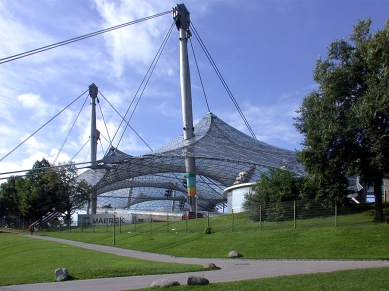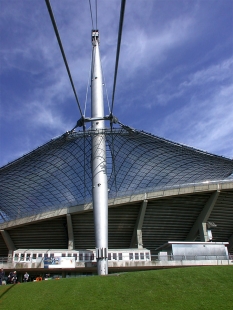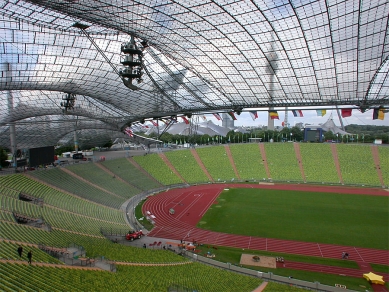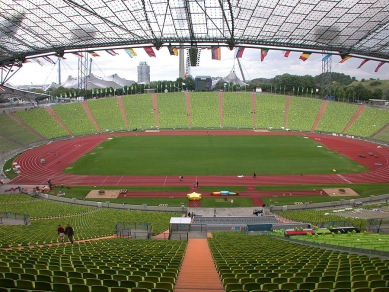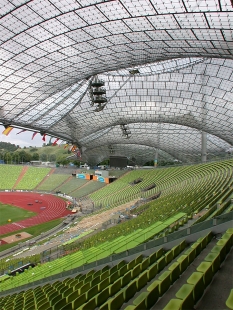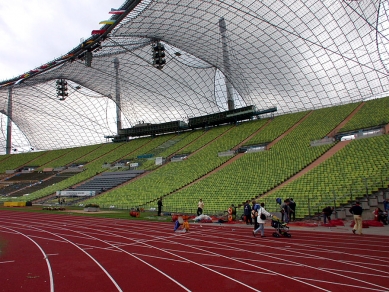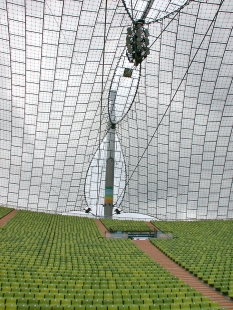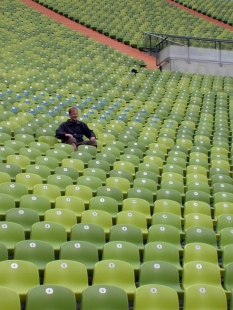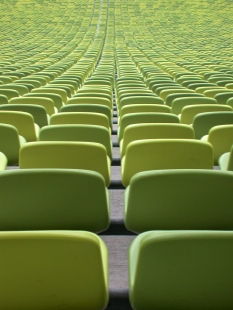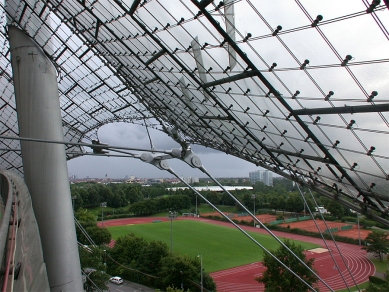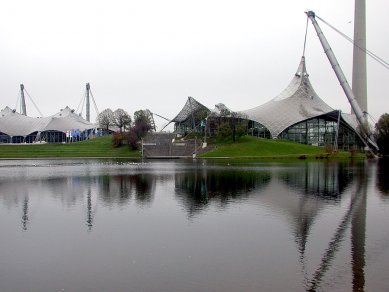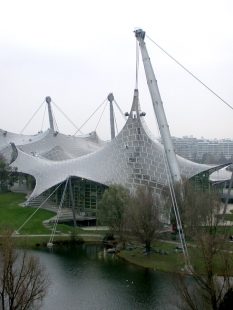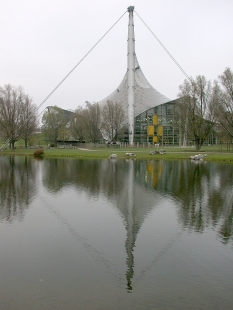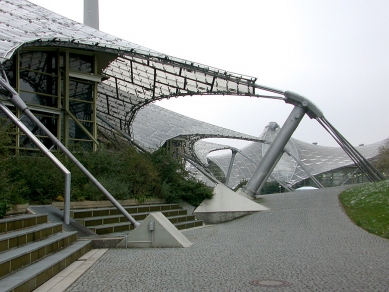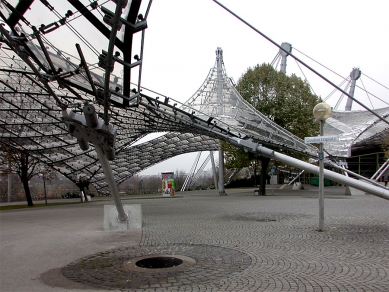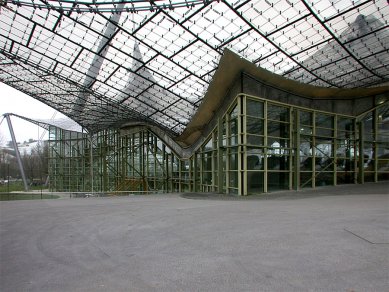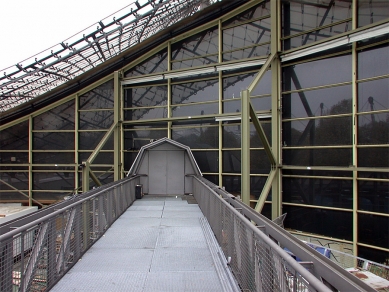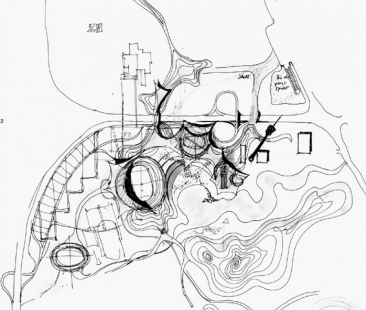
Olympic Complex

The Federal Republic of Germany was chosen as the host of the 20th Summer Olympics. Munich, the capital of Bavaria, was selected as the venue. After 36 years, the Olympic flame burned again in a country that had previously misused the Olympics to promote the most terrible ideology in the world. Politicians and especially the jury of the architectural competition for the new sports complex were aware of this shadow. However, it was only by a hair's breadth that conventional sports facilities, whose concepts were more or less in line with the contemporary standard, could have stood in Munich today. Thanks to Egon Eiermann, the chair of the jury, and many influential politicians, however, the commission for realization was awarded to the forty-five-year-old Günter Behnisch. His project became a symbol of the transformational processes in West Germany in the 1960s.
Behnisch's concept of tent-like roof structures, which naturally and unpretentiously united all sports venues into one harmonious complex, was not innovative. Such large-scale cable structures had already been used by Behnisch's colleague Rolf Gutbrod at Expo '67 in Montreal. However, we must consider the German designer and structural engineer Frei Otto 100% the author of these structures. Tent structures were a national treasure of Germany at the time of architectural achievements.
As the motto of the Munich Olympics, the following was chosen: "Olympic Games in a natural environment, with short connections; a festival of the muses and sports". To satisfy this idea of the organizing committee led by Willi Daum, Günter Behnisch collaborated with the aforementioned master of flat constructions - engineer Frei Otto, landscape architect Günther Grzimek, and graphic designer Otl Aicher. The Olympic complex in Munich is thus a true teamwork.
The location on the outskirts of Munich offered great potential. Behnisch's team reshaped the heaps of construction debris that had been brought here after the war from the bombed city of Munich into the form of green hills. The originally uninteresting Nymphenburg Canal was deepened and widened into a pleasant form of a smaller lake. A transparent steel and perspex roof threads through the entire park, covering the sports venues and the adjoining public spaces. Dominating the complex is a 290-meter high television tower. The environment is indeed tailored for "peaceful and joyful games", which the Munich councilors dreamed of.
The largest building in the complex is the Olympic Stadium. The tent roof covers most of its seating and protects spectators from rain. The sophisticated supporting structure continues to evoke unprecedented admiration even after 30 years. Observing it is a pleasure, perhaps due to the inspiration derived from nature Frei Otto. This controversial load-bearing structure soon became associated not only with Munich but with all of West Germany as it evolved into a modern democratic state. There is nothing left but to take our hats off…
Behnisch's concept of tent-like roof structures, which naturally and unpretentiously united all sports venues into one harmonious complex, was not innovative. Such large-scale cable structures had already been used by Behnisch's colleague Rolf Gutbrod at Expo '67 in Montreal. However, we must consider the German designer and structural engineer Frei Otto 100% the author of these structures. Tent structures were a national treasure of Germany at the time of architectural achievements.
As the motto of the Munich Olympics, the following was chosen: "Olympic Games in a natural environment, with short connections; a festival of the muses and sports". To satisfy this idea of the organizing committee led by Willi Daum, Günter Behnisch collaborated with the aforementioned master of flat constructions - engineer Frei Otto, landscape architect Günther Grzimek, and graphic designer Otl Aicher. The Olympic complex in Munich is thus a true teamwork.
The location on the outskirts of Munich offered great potential. Behnisch's team reshaped the heaps of construction debris that had been brought here after the war from the bombed city of Munich into the form of green hills. The originally uninteresting Nymphenburg Canal was deepened and widened into a pleasant form of a smaller lake. A transparent steel and perspex roof threads through the entire park, covering the sports venues and the adjoining public spaces. Dominating the complex is a 290-meter high television tower. The environment is indeed tailored for "peaceful and joyful games", which the Munich councilors dreamed of.
The largest building in the complex is the Olympic Stadium. The tent roof covers most of its seating and protects spectators from rain. The sophisticated supporting structure continues to evoke unprecedented admiration even after 30 years. Observing it is a pleasure, perhaps due to the inspiration derived from nature Frei Otto. This controversial load-bearing structure soon became associated not only with Munich but with all of West Germany as it evolved into a modern democratic state. There is nothing left but to take our hats off…
The English translation is powered by AI tool. Switch to Czech to view the original text source.
0 comments
add comment


